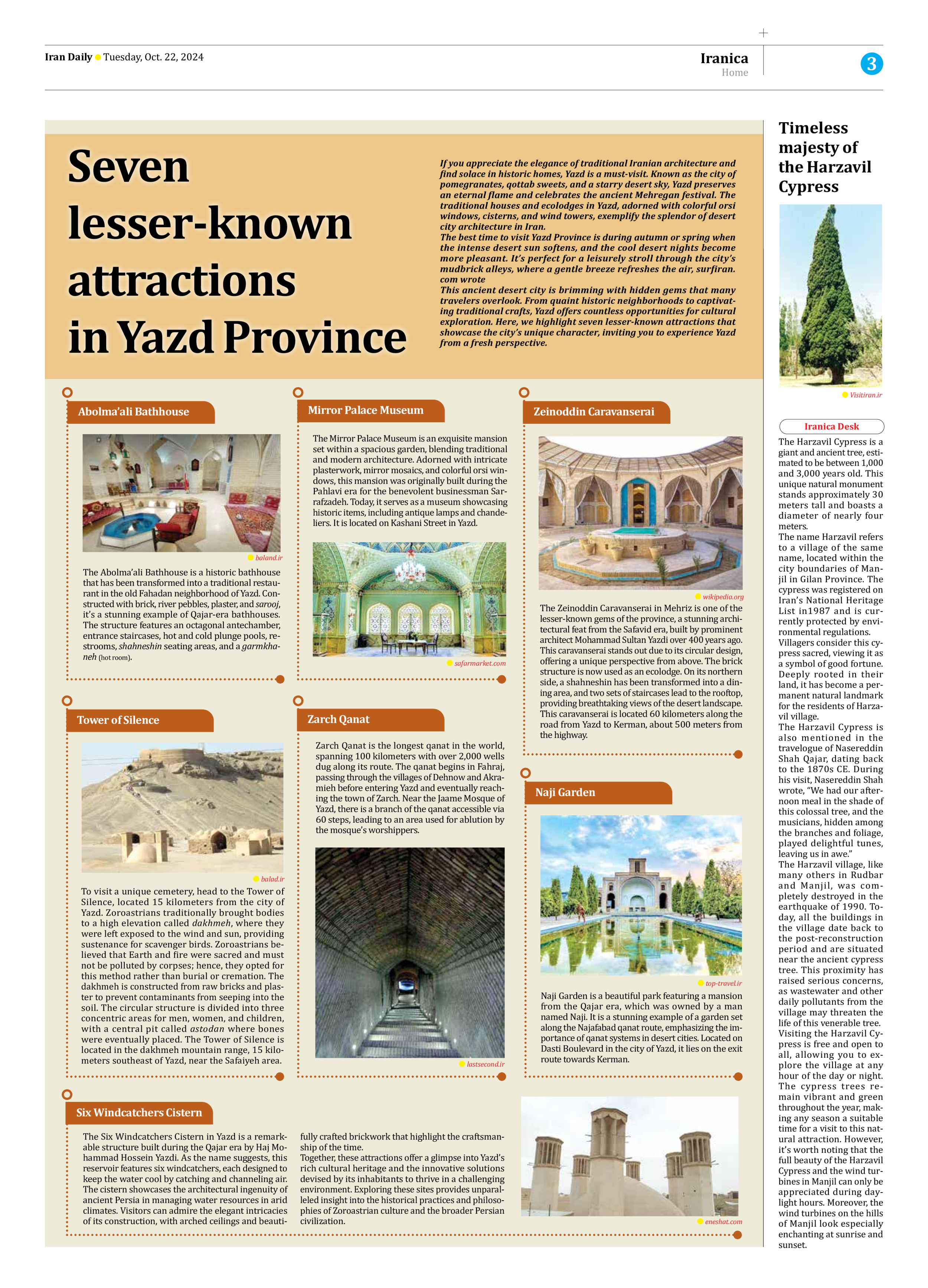
Seven lesser-known attractions in Yazd Province
If you appreciate the elegance of traditional Iranian architecture and find solace in historic homes, Yazd is a must-visit. Known as the city of pomegranates, qottab sweets, and a starry desert sky, Yazd preserves an eternal flame and celebrates the ancient Mehregan festival. The traditional houses and ecolodges in Yazd, adorned with colorful orsi windows, cisterns, and wind towers, exemplify the splendor of desert city architecture in Iran. The best time to visit Yazd Province is during autumn or spring when the intense desert sun softens, and the cool desert nights become more pleasant. It’s perfect for a leisurely stroll through the city’s mudbrick alleys, where a gentle breeze refreshes the air, surfiran.com wrote This ancient desert city is brimming with hidden gems that many travelers overlook. From quaint historic neighborhoods to captivating traditional crafts, Yazd offers countless opportunities for cultural exploration. Here, we highlight seven lesser-known attractions that showcase the city’s unique character, inviting you to experience Yazd from a fresh perspective.
Abolma’ali Bathhouse
The Abolma’ali Bathhouse is a historic bathhouse that has been transformed into a traditional restaurant in the old Fahadan neighborhood of Yazd. Constructed with brick, river pebbles, plaster, and sarooj, it’s a stunning example of Qajar-era bathhouses. The structure features an octagonal antechamber, entrance staircases, hot and cold plunge pools, restrooms, shahneshin seating areas, and a garmkhaneh (hot room).
Mirror Palace Museum
The Mirror Palace Museum is an exquisite mansion set within a spacious garden, blending traditional and modern architecture. Adorned with intricate plasterwork, mirror mosaics, and colorful orsi windows, this mansion was originally built during the Pahlavi era for the benevolent businessman Sarrafzadeh. Today, it serves as a museum showcasing historic items, including antique lamps and chandeliers. It is located on Kashani Street in Yazd.
Zeinoddin Caravanserai
The Zeinoddin Caravanserai in Mehriz is one of the lesser-known gems of the province, a stunning architectural feat from the Safavid era, built by prominent architect Mohammad Sultan Yazdi over 400 years ago. This caravanserai stands out due to its circular design, offering a unique perspective from above. The brick structure is now used as an ecolodge. On its northern side, a shahneshin has been transformed into a dining area, and two sets of staircases lead to the rooftop, providing breathtaking views of the desert landscape. This caravanserai is located 60 kilometers along the road from Yazd to Kerman, about 500 meters from the highway.
Tower of Silence
To visit a unique cemetery, head to the Tower of Silence, located 15 kilometers from the city of Yazd. Zoroastrians traditionally brought bodies to a high elevation called dakhmeh, where they were left exposed to the wind and sun, providing sustenance for scavenger birds. Zoroastrians believed that Earth and fire were sacred and must not be polluted by corpses; hence, they opted for this method rather than burial or cremation. The dakhmeh is constructed from raw bricks and plaster to prevent contaminants from seeping into the soil. The circular structure is divided into three concentric areas for men, women, and children, with a central pit called astodan where bones were eventually placed. The Tower of Silence is located in the dakhmeh mountain range, 15 kilometers southeast of Yazd, near the Safaiyeh area.
Zarch Qanat
Zarch Qanat is the longest qanat in the world, spanning 100 kilometers with over 2,000 wells dug along its route. The qanat begins in Fahraj, passing through the villages of Dehnow and Akramieh before entering Yazd and eventually reaching the town of Zarch. Near the Jaame Mosque of Yazd, there is a branch of the qanat accessible via 60 steps, leading to an area used for ablution by the mosque’s worshippers.
Naji Garden
Naji Garden is a beautiful park featuring a mansion from the Qajar era, which was owned by a man named Naji. It is a stunning example of a garden set along the Najafabad qanat route, emphasizing the importance of qanat systems in desert cities. Located on Dasti Boulevard in the city of Yazd, it lies on the exit route towards Kerman.
Six Windcatchers Cistern
The Six Windcatchers Cistern in Yazd is a remarkable structure built during the Qajar era by Haj Mohammad Hossein Yazdi. As the name suggests, this reservoir features six windcatchers, each designed to keep the water cool by catching and channeling air. The cistern showcases the architectural ingenuity of ancient Persia in managing water resources in arid climates. Visitors can admire the elegant intricacies of its construction, with arched ceilings and beautifully crafted brickwork that highlight the craftsmanship of the time.
Together, these attractions offer a glimpse into Yazd’s rich cultural heritage and the innovative solutions devised by its inhabitants to thrive in a challenging environment. Exploring these sites provides unparalleled insight into the historical practices and philosophies of Zoroastrian culture and the broader Persian civilization.







